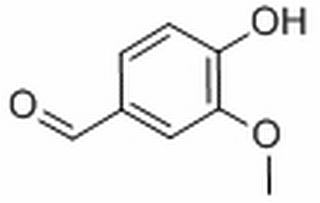Home
Products
Vanillin



| Product Name | Vanillin |
| Price: | $15 / 20mg |
| Catalog No.: | CN03910 |
| CAS No.: | 121-33-5 |
| Molecular Formula: | C8H8O3 |
| Molecular Weight: | 152.14 g/mol |
| Purity: | >=98% |
| Type of Compound: | Phenols |
| Physical Desc.: | Powder |
| Source: | The roots of Beta vulgaris |
| Solvent: | Chloroform, Dichloromethane, Ethyl Acetate, DMSO, Acetone, etc. |
| SMILES: | COc1cc(C=O)ccc1O |
| Contact us | |
|---|---|
| First Name: | |
| Last Name: | |
| E-mail: | |
| Question: | |
| Description | Vanillin is a single molecule extracted from vanilla beans and also a popular odor used widely in perfume, food and medicine. |
| Target | Human Endogenous Metabolite |
| In Vitro | Vanillin recovers UVA-induced reduction of proliferation in a dose dependent manner. Vanillin has no apoptotic effects at the tested concentrations. In addition, the reduced expression levels of OCT4, NANOG, and SOX2 caused by UVA irradiation are allincreased by Vanillin treatment, suggesting that Vanillin attenuates the effects of UVA irradiation on hAMSCs. Based on a luciferase reporter assay, Vanillin increases the reduced activity of HRE-luciferase reporter caused by UVA irradiation. In addition, treatment with Vanillin attenuates the reduced expression of HIF-1α caused by UVA irradiation. The results reveal that treatment of hAMSCs with Vanillin results in significant decrease in the production of PGE2 and cAMP when compare to UVA-irradiated controls[1]. |
| In Vivo | Following antidepressant treatment for 4 weeks, immobility time in the stress+Vanillin and stress+fluoxetine groups is significantly decreased [F(4,42)=34.73, P<0.01; F(4,42)=13.55, P<0.01, respectively]. Treatment with Vanillin or fluoxetine remarkably alleviates the decrease in sucrose consumption in CUMS model animals [F(4,42)=12.32, P<0.01; F(4,42)=5.65, P<0.01, respectively]. In CUMS model rats, 5-HT level in the stress+Vanillin and stress+fluoxetine groups is significantly increased when compare with the stress group [F(4,42)=4.846, P=0.030; F(4,42)=4.846, P=0.036, respectively], whereas noradrenaline (NE) in the two groups is elevated but not significantly [F(4,42)=6.977, n.s.]. Dopamine (DA) is also significantly increased in the stress+Vanillin group compare with the stress group [F(4.42)=6.174, P=0.041][2]. |
| Cell Assay | hAMSCs are irradiated with the indicated doses of UVA and then incubated with 1 to 100 μM of Vanillin for three days under serum-free conditions (in DMEM devoid of serum, at 37°C with 5% CO2). After three days, cell proliferation is measured using BrdU incorporation assay[1]. |
| Animal Admin | Male Sprague-Dawley rats (200 to 250 g) are used in this study. The animals are divided into three groups with 8 to 10 rats per group: the stress+fluoxetine group; the stress+Vanillin aromatherapy group and the stress (untreated) group. For the stress+fluoxetine group, the animals are administered a daily oral dose (10 mg/kg/d, diluted in distilled water) of the SSRI fluoxetine each morning. For the stress+Vanillin group and the bulbectomy+Vanillin group, Vanillin is administrated in a Plexiglas cylinder 50 cm tall and 35 cm diameter with two layers separated by a porous Plexiglas board. The rat still in its cage is gently placed on the upper layer, and 5 mL of 600 mg/L Vanillin (in distilled water) sprayed on to the floor of the lower layer. Rats in the stress and the control groups receive similar handling to the stress+Vanillin group, but without any odor administrated[2]. |
| Density | 1.2±0.1 g/cm3 |
| Boiling Point | 282.6±20.0 °C at 760 mmHg |
| Flash Point | 117.6±15.3 °C |
| Exact Mass | 152.047348 |
| PSA | 46.53000 |
| LogP | 1.19 |
| Vapour Pressure | 0.0±0.6 mmHg at 25°C |
| Storage condition | Refrigerator |